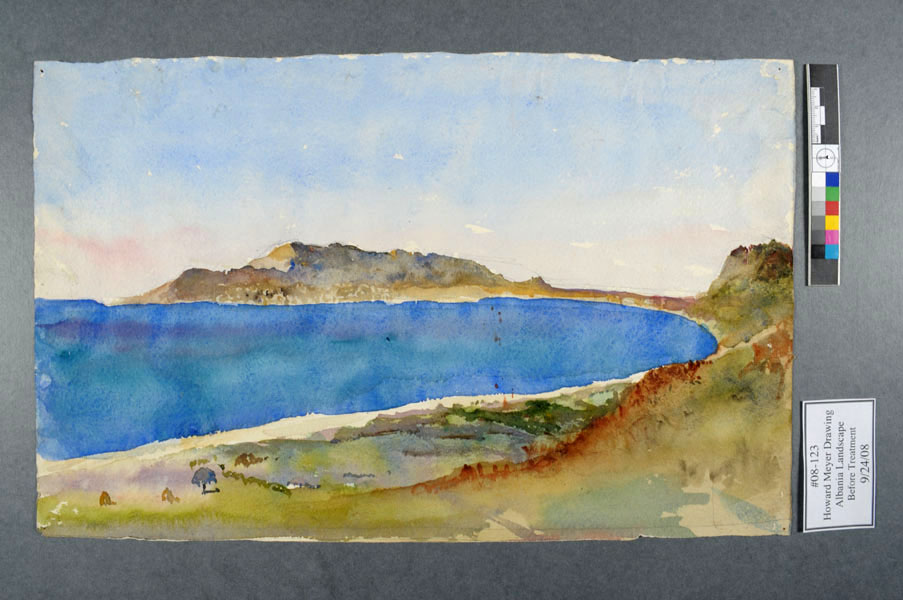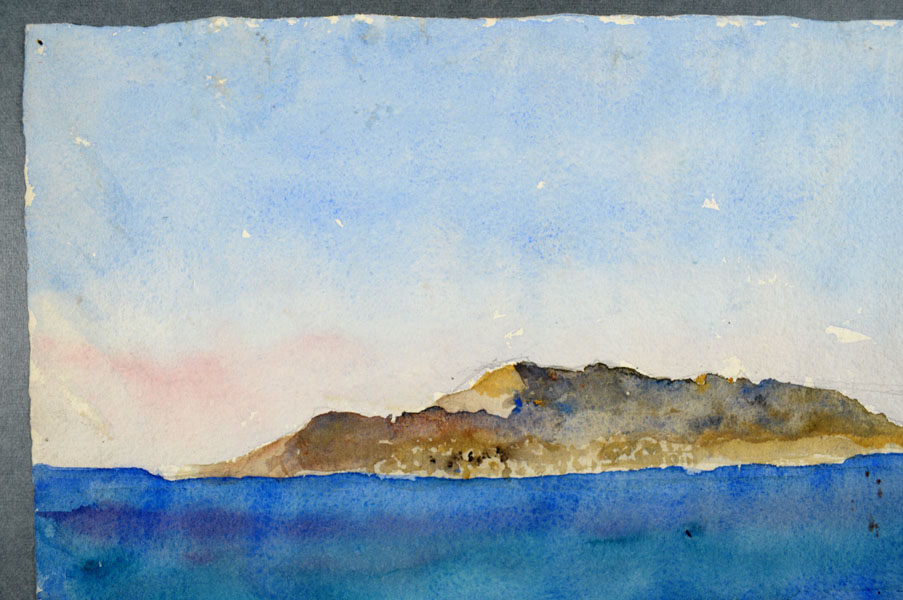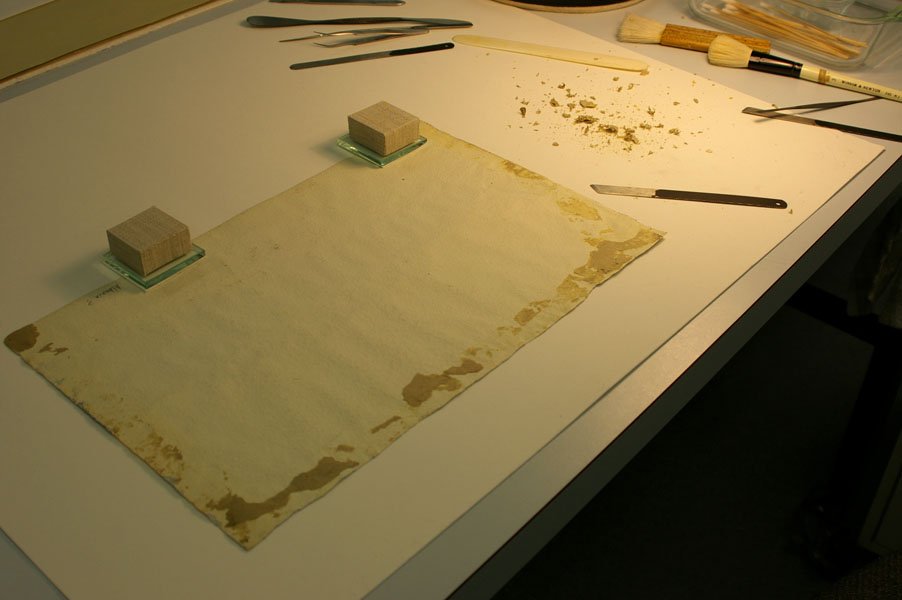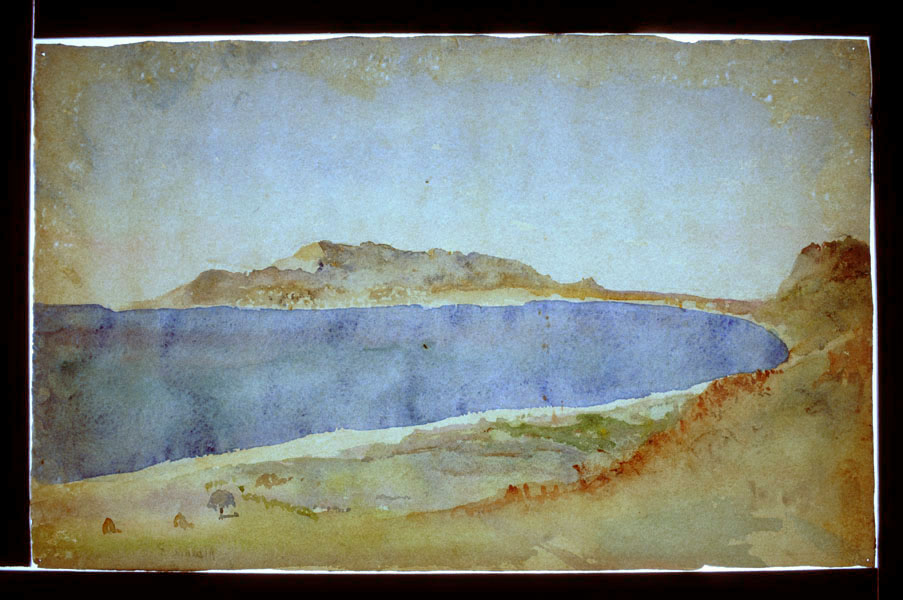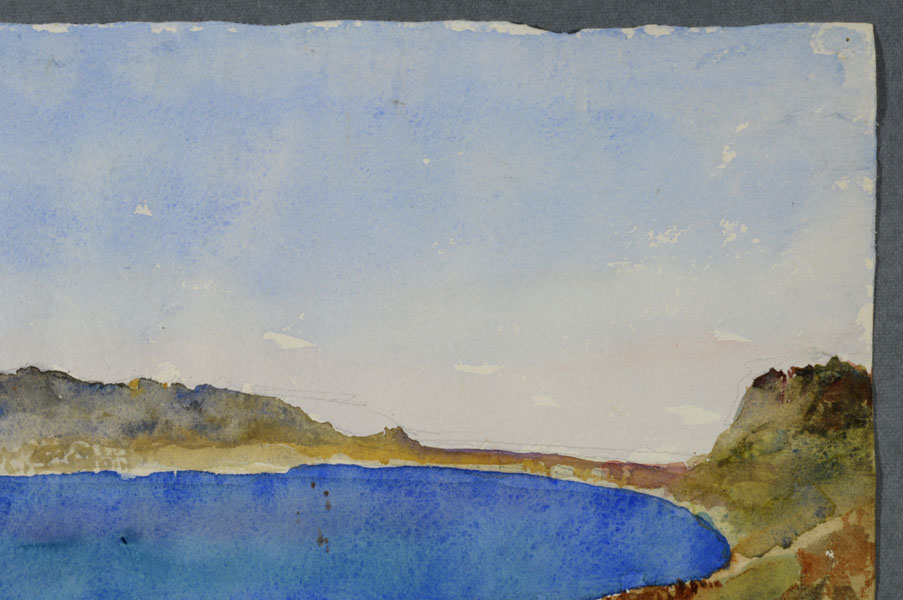Paper Treatments
Albania, Howard Meyer watercolor
Fragment and adhesive removal
Photo Documention
- Before
- During
- After
Click thumbnails to view images.
Treatment Report
Date: September 25, 2008
Temporary Identification number: #08-123
Owner/Custodian: Nancy Sparrow
Address: Alexander Architectural Archive, University of Texas at Austin
Telephone: 512-495-4621
Owner/Custodian call no.: MEY-9
Title/Subject/Description (.01): Albanian Landscape
Creator: Howard R. Meyer, Architect
Date of production: c. 1935
Place of production: Dallas, TX
Approximate dimensions (hxw): 9 5/8 x 15 3/8 in., 24.5 x 38.8 cm
Conservator: Beth Antoine
Treatment Objective
The goal of this treatment is to stabilize the drawing to extend its useful life and enable safe handling for use by researchers.
Historical Significance
The watercolor landscape was painted by Howard R. Meyer, a prolific 20th century Dallas architect, known for his Modernist residential designs. With the great majority of his extant work being architectural drawings, it is interesting to see his work in another genre.
Description & Condition
The work of art is in good condition overall with adhesive residue, staining, and fragments of a previous mount on the verso, which may result in further staining and degradation of the substrate if not removed.
General
Primary support (hxw): 9 5/8 x 15 3/8 in. (24.5 x 38.8 cm)
Image area (hxw): 9 5/8 x 15 3/8 in. (24.5 x 38.8 cm)
The painting on watercolor paper depicts a distant mountainous landscape surrounding a body of water with the horizon line just above the center of the composition. A deep, vivid blue with striations of purple and green, the body of water extends from the left just below the horizon, nearly to the right edge of the image. The beach area surrounding the water is defined by beige and green washes with the lightest lights lacking any media at all. Darker, more heavily applied strokes of green and reddish brown define the ridge that extends across the foreground from the right of the water down to the center of the image. Other than a few small trees in the foreground, the landscape lacks fine detail. It consists mainly of areas of light and shadow with tonal shifts expressing depth and volume. The colors are crisp and vibrant with many of the washes blending multiple pigments. The foreground appears somewhat more defined than the soft and muted background, as the mountains in the distance are a mixture of earth browns and ochres with an overlay of blue and purple. The sky is a lightly applied wash of pinks and blues with no hard lines or edges. The image area fills the page entirely.
Primary Support
The primary support is a cream colored, heavy weight, heavily textured watercolor paper. It is a high quality paper with even pulp distribution. The paper is in very good condition overall with no tears or losses, and it has retained its soft, flexible character. Raking light reveals fairly severe cockling throughout the sheet especially at the top edge, which may have occurred at the time of production or as a result of improper storage thereafter. Small pinholes at all four corners indicate that the work was likely tacked up for display at some point. The sheet was trimmed unevenly and slightly out of square. Adhesive residue, staining, and board fragments appear on the verso approximately one and a half inches wide around all edges except the bottom, likely the result of inappropriate removal of a pre-existing mount.
Media
Watercolor
Several watercolor pigments are applied from very lightly to very heavily. In many areas multiple pigments are well integrated, while in others they stand alone. Overall, the media appears stable with none of the pigments showing symptoms of cracking, flaking, or fading. There is a chunk of blue pigment in center of the body of water that is somewhat raised above the plane of the image. In a few locations, areas of gum Arabic mixed with or overlaying the pigment appear glossy in raking light. This condition is noticeable in the green areas just below the water and in some of the blue areas of the water.
Graphite Under-drawing
Likely a hard graphite, the dull, light gray line drawing appears just above and just below the horizon, below the water line, and at the bottom edge of the sheet. It is lightly applied beneath the watercolor media.
Graphite Annotation
On the bottom left of the verso, a graphite annotation reads, "Albania?" The light gray writing is likely a cataloguer's annotation referring to the possible subject of the landscape.
Treatment Proposal
- Remove adhesive and backing residue as possible.
- Reduce staining as possible.
- House in acid-free folder.
Photography
Digital images were taken of the recto, verso, and details in ambient, raking and transmitted light.
Possible Effects of Treatment
Effective stain reduction may not be possible.
Treatment Performed
- Mechanical removal of board fragments and adhesive residue using lifting knives and a microspatula. Note: Softening the adhesive with methylcellulose on cotton swabs was tested on the lower left corner, but the adhesive was driven further into the paper, so the method was not continued. (6.25 hrs)
- Housed in a folder of interleaving paper inside of a folder of 20pt. card stock. (15 min.)
Total Treatment Time: 6.5 hours
Materials Used
Cotton blotter paper, Talas, 2004
20 pt. folder stock, Conservation Resources, 2004
Buffered Interleaving paper, Light Impressions Apollo
